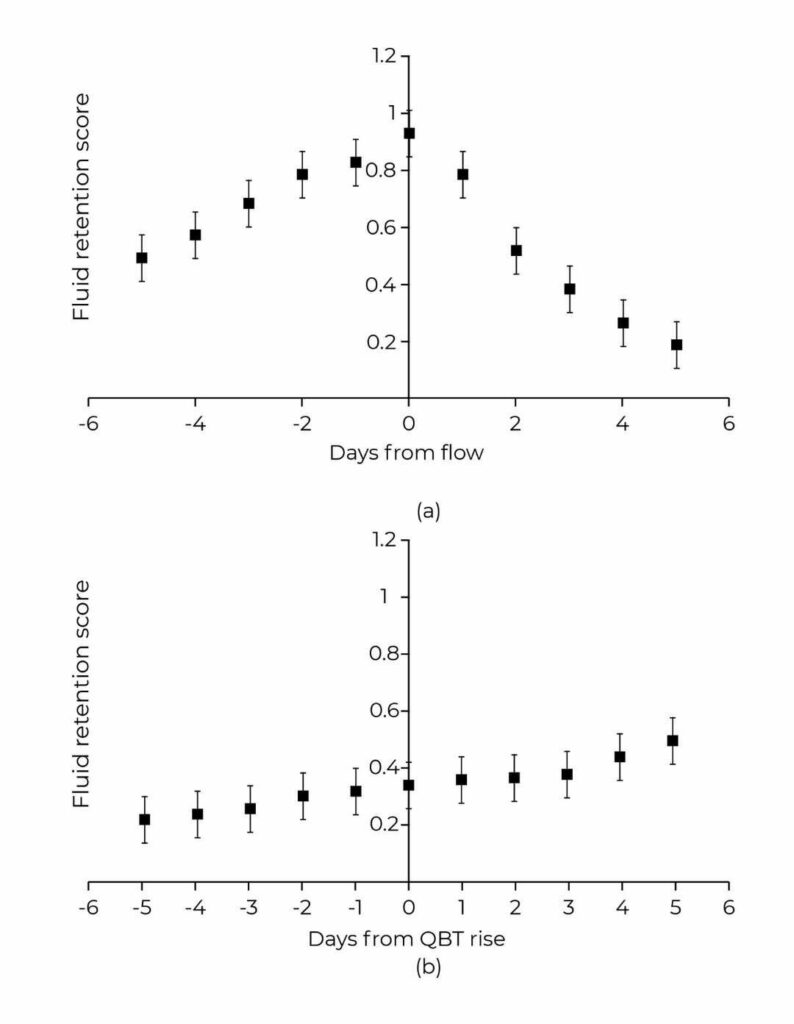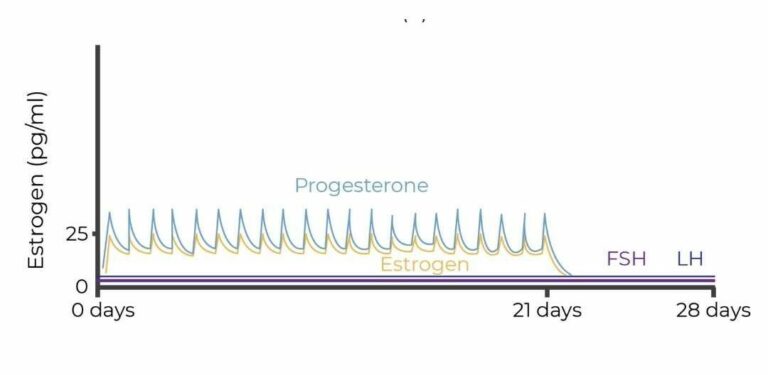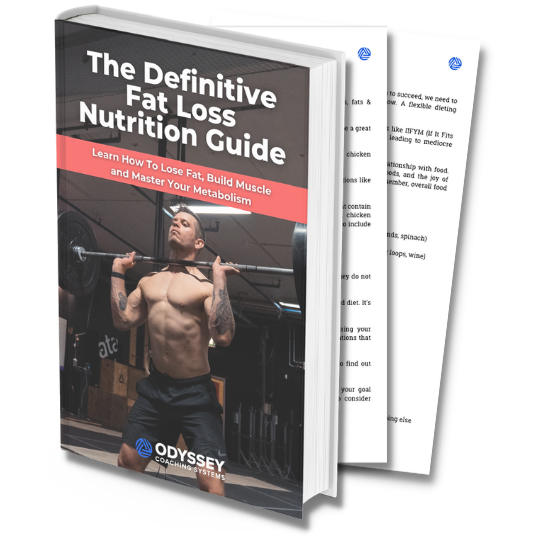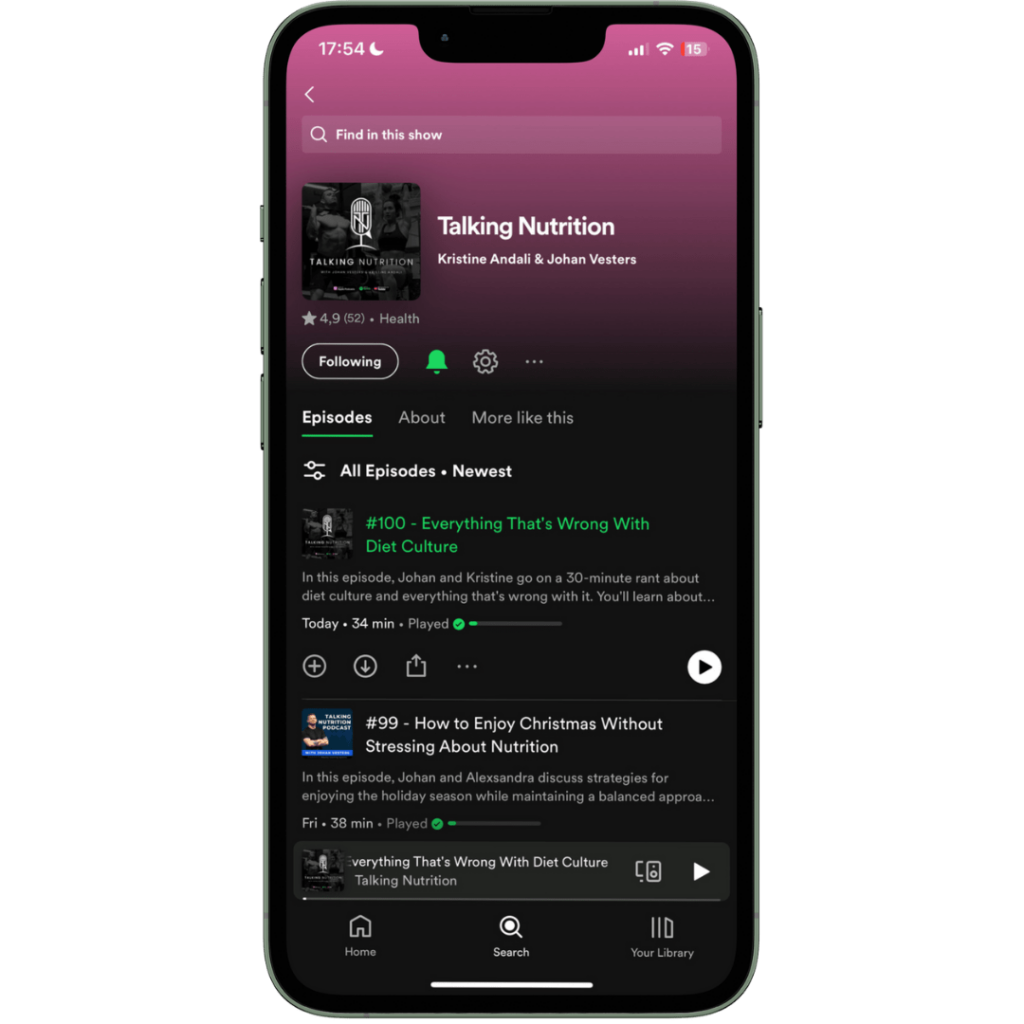Main Take-Aways
1. The average menstrual cycle lasts about 28 days and consists of two phases. The Follicular phase and the Luteal phase. These phases come with their own ebbs and flows in hormones and physiological changes.
2. If you’re on hormonal birth control, the whole Cycle Syncing concept goes out the door. However you may still benefit from the nutrition, training and lifestyle changes discussed.
3. Learn to understand how your body feels, works, and responds to different life stressors, as well as dietary and lifestyle changes. Do enough of your own research first and then decide if you need to make any changes based on your cycle or not.
Through the different stages of your menstrual cycle you might experience changes in mood, sleep, performance, hunger, cravings, bloating, body weight, and more.
One moment you feel like you’re on top of the world. You’re highly motivated, you’re setting PR’s at the gym, your nutrition is on point..
Then all of the sudden you just can’t be bothered to even step foot in the gym. On top of that you struggle with cravings, you feel more stressed and your weight is up by a few kg.
Sound familiar?
In this article you will learn about the different phases of the menstrual cycle, how your hormones can affect your body, nutrition and training, how to track your metrics, and whether ‘cycle syncing’ is something you should do.
We’ll start off a little more sciencey. But stick around, because afterwards we’ll switch back to normal English and get more practical.
Before we begin, two important things:
- What we’ll discuss in this article applies to the otherwise healthy female who has a normal healthy cycle, isn’t pregnant, isn’t going through menopause, and isn’t struggling with conditions like PCOS, REDS, etc.
- Things also change if you are on hormonal birth control. If that’s the case, feel free to jump to this section before reading the rest of this article. Either way, you can still apply some of the strategies we’ll touch on based on how you feel.
Menstrual Cycle
The average menstrual cycle lasts about 28 days and consists of two phases. The Follicular phase and the Luteal phase. These phases come with their own ebbs and flows in hormones and physiological changes.
Before we get into these phases, I’ll give you a quick breakdown of the main hormones that play a role in the menstrual cycle:
- FSH (Follicle-Stimulating Hormone)
Produced in the brain. Stimulates ovarian follicles to grow. - LH (Luteinizing Hormone)
Produced in the brain. Signals your ovary to release an egg. - Estrogen
Mainly produced by the ovaries. Stimulates the uterine lining to grow and thicken to prepare for pregnancy.Often gets a bad rap, but is essential for female health, and comes with many benefits.Estrogen boosts serotonin and dopamine, stimulating mood and libido. Reduces inflammation and muscle soreness, and positively affects muscle building, insulin sensitivity, sleep, and more. - Progesterone
Mainly produced by the corpus luteum. Prepares the body for pregnancy if an egg is fertilized.Works cancer protective, reduces inflammation, boosts metabolism (by stimulating thyroid hormone), immune system and energy, improves sleep, hair, clear skin, bones, muscle, and more. - (Testosterone)
Yep, also women produce and need testosterone. It’s essential for muscle building and strength, libido, reproductive health, mood, energy and more.
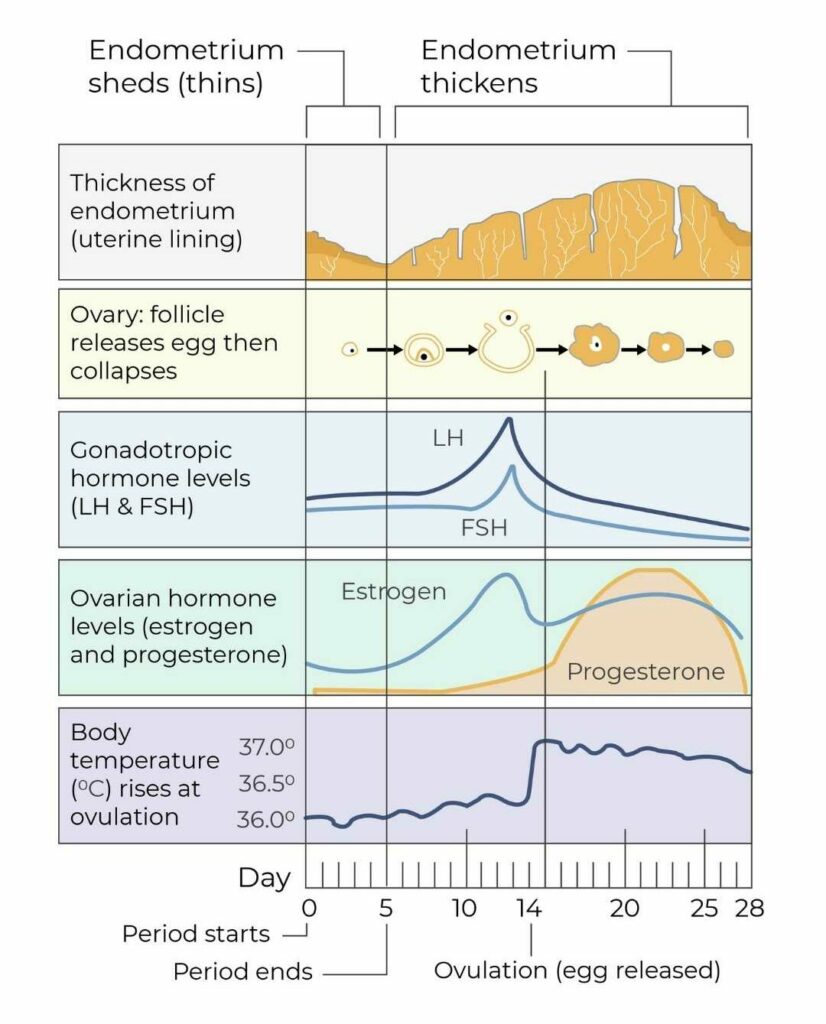
Follicular phase (Estrogen dominant)
The follicular phase, the first half of your cycle, lasts about 14 days on average and begins on day 1 of menstruation when the uterine lining sheds. If your cycle is shorter/longer than 28 days, it has to do with the follicular phase being shorter/longer. The luteal phase is always 14 days.
FSH stimulates the ovaries to grow up to 20 follicles, which are little ‘sacs’ that contain immature eggs. Usually only one ‘makes it’ and becomes an egg. As the follicles develop, also the uterine lining begins to thicken again.
Estrogen rises gradually, until FSH and LH peak, and ovulation gets triggered. Higher estrogen levels mean better sleep, performance and recovery, less hunger, fewer cravings, and improved insulin sensitivity.
Being more insulin sensitive is a good thing, it means that your cells become better at processing carbohydrates and regulating your blood sugar levels.
Towards the end of the follicular phase, after menstruation and right before ovulation, there’s also a rise in testosterone. Because of that rise in testosterone, many women experience their best performance in the gym around this time.
Tip: this could be a great moment to focus on getting some awesome training sessions in, and push a little harder.
Luteal phase (Progesterone dominant)
The luteal phase, the second half, also lasts about 14 days on average and begins with the main event of your menstrual cycle: ovulation. Estrogen and testosterone decrease as Progesterone takes over.
When an egg is released, it travels down the fallopian tube where it may or may not be fertilized. In the meantime, what’s left of the follicle becomes what’s called the Corpus Luteum. This acts almost like a ‘temporary’ organ that produces progesterone.
If no pregnancy occurs your hormones drop, the body gets rid of the corpus luteum, the uterine lining sheds and the menstrual cycle starts over.
Tip: Want actual proof that you’re ovulating? Tracking your body temperature can help you understand your cycle and so "help achieve or prevent pregnancy (1)". I’ll link some good resources at the end of this article if you want to learn more.
Progesterone speeds up your metabolism by about 100 – 300 calories per day, which increases your body temperature (2) by about 0.5 – 1 °C.
But don’t get too excited just yet. Around the same time you may also experience more hunger and cravings, stress, anxiety, moodswings, trouble sleeping, lower motivation, decreases in performance and strength, an increased risk of injury, and with all that a risk of overeating more than the extra calories burned.
Lastly you’re also less insulin sensitive around this time. Meaning that if you do overeat, your body won’t be able to handle the extra nutrients coming in as well as it would during the follicular phase.
Great.. So what does this all mean for your training, nutrition, and results?
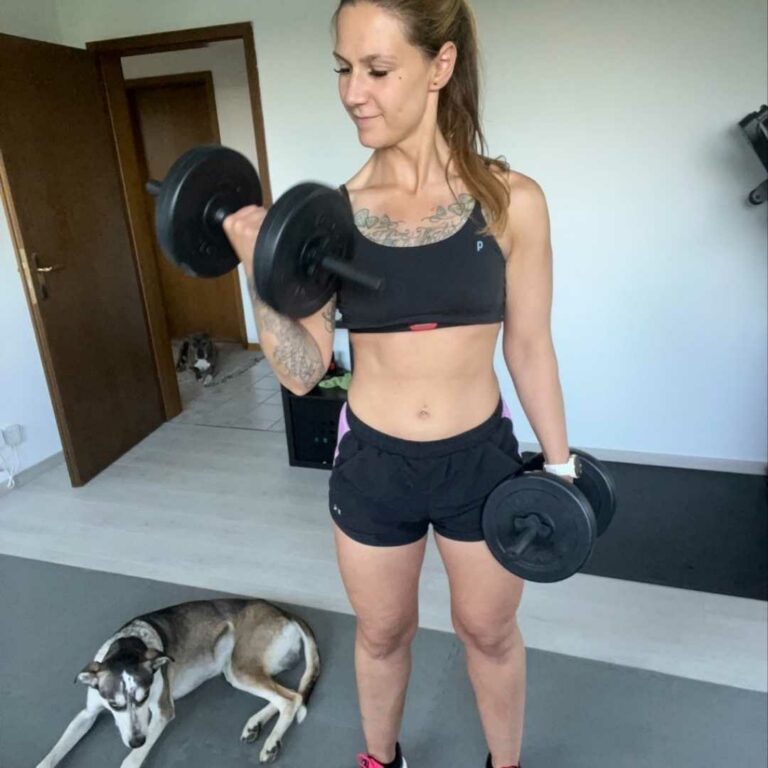
Cycle Syncing: Training
You just learned that the first half of your menstrual cycle can be great for training. Although it can be a little more uncomfortable to train during menstruation, your body is often more ready to push the weights.
Especially towards the end of the follicular phase, you could leverage the fact that testosterone is higher. More strength, better performance, plus you generally recover better around this time.
Depending on your program and the type of training/sport you participate in, you could plan/move peak weeks, tests, 1RM attempts, etc. to this part of your menstrual cycle.
During the second half, consider dialing things back. Though only if you feel like you really need to. While one person calls it hell-week, the other doesn’t experience much of a difference at all. A possible strategy could be pushing your workouts for 3 weeks, before taking your foot off the gas during the 4th week. Consider it your monthly deload, where you cut yourself some slack.
Since sleep – which is essential for recovery – is often affected around the same time, you can also allow for more time in bed to get more rest.
Cycle syncing: Nutrition
Let me start off by saying that a lot of the following changes require more puzzling and planning. You also do not have to, but maybe you’ll benefit from making certain changes. What it’s going to be in your case, depends. Learn to understand your body, try things out, and figure out what works best for you.
Knowing that your metabolism does increase during the luteal phase, you could even allow yourself to eat those extra 100 – 300 calories. Planning for more food when you need it can teach you to be more flexible and keep you from overeating.
Especially the second half of your cycle often comes with more hunger and cravings – which could have to do with your increased metabolism – so it can be a good idea to eat more protein (3), fruits, and vegetables around this time.
Protein because it’s the most satiating macronutrient and fruits/veggies because both the volume of these foods and the fiber that comes with them will also keep you fuller longer.
Cycle syncing aside, both sleep and stress have a big impact on hunger and cravings. So if you already have a hard time getting enough (quality) sleep, and your stress levels are through the roof, then I’d start there rather than making any changes based on the menstrual cycle.
The changes in insulin sensitivity don’t have to be an issue. If you’re generally in a healthy place, you don’t really have to make any dietary changes based on insulin sensitivity. But if you’re dealing with a condition like PCOS or insulin resistance, you could benefit from swapping out more carbs for fats. Another way to combat insulin resistance would be eating in a calorie deficit.
Related articles to these nutritional changes:
Read: Tips to fall asleep.
Read: Managing stress.
Read: Benefits of protein.
Read: High protein foods cheat sheet.
Read: Low calorie, filling foods.
Water retention
Ever experience some bloating?
Both in the case of a menstrual cycle and hormonal birth control your body weight and measurements can fluctuate, and how you can track these metrics more effectively.
Estrogen and Progesterone both affect how your body holds onto water. Now that you know how both hormones ebb and flow throughout the menstrual cycle, you’ll understand that comparing your metrics day-to-day, or even week-to-week, might not be the best way to track your progress.
Water retention seems to increase (4) during the last week of your cycle, peaks at menstruation, and then slowly decreases again throughout the follicular phase.
That means that before and during menstruation you can expect your weight to either go up, or at least stop moving if you’re in a weight loss phase.
The same goes for body girth measurements, especially around the waist and hips.
How to track your metrics
Our online nutrition clients usually weigh themselves daily, or at least 3 times a week. They then plug their numbers into their tracker, which shows their average weekly weight. Body girth measurements are usually done once every two weeks, and progress photos once a month.
Weighing in daily will show you how normal daily weight fluctuations are, and how things like stress, sleep, salt intake, hydration, food choices, and training can influence that number on the scale.
Want to see how you’re progressing? Make sure to compare your weekly weight or measurements to the same week of your previous cycle.
Compare week 1 (menstruation) to week 1,
Compare week 2 (before ovulation) to week 2,
Week 3 (after ovulation) to week 3,
And week 4 (before menstruation) to week 4.
Let’s be honest, no one really likes to see the scale go up from one day to another. But know that even if you gain multiple kilos, it’s probably just going to be water weight. Give it some time, because usually that weight goes right back down to where it was.
Synthetic hormonal fluctuations while taking an oral contraceptive containing both estrogen and progesterone
Does Hormonal Birth Control change things?
Hormonal Birth Control (HBC) works by shutting down communication between the brain and the ovaries. You stop ovulating (unless you’re using a hormonal IUD) and stop producing estrogen and progesterone.
That means that even though you’re getting synthetic hormones (which are not the same) from your HBC, your own hormones are completely flatlined. No more natural ebbs and flows throughout your cycle.
Does this mean that the whole Cycle Syncing idea goes out the door when you’re on hormonal birth control? Yes, however..
Even on HBC, it can still be a good idea to create awareness around how you feel throughout the month. Different forms of HBC come with different side effects and you may still notice changes in hunger, cravings, water retention, performance, sleep, recovery, etc.
Pay attention to how your body performs and feels, and see if you could possibly still benefit from the strategies we talked about earlier (adjusting training, sleep, filling foods, more protein, etc.).
All things health and fitness should really be personalized to you, which is where a coach could come in handy. If you’d like to learn more about how I can help you, then feel free to book a call with me. No strings attached!
Exogenous hormones of birth control (BC) modulate the recovery metrics in a different pattern than the natural menstrual cycle (5), with reduced indices of adaptation to stress across all pill phases.
Exogenous hormone use significantly impacts day to day recovery to increased cardiovascular strain (5) as compared with the natural menstrual cycle.
Understanding your body
Thanks for still being here. I hope that you found this information as useful as I enjoyed diving into this topic and writing about it.
Now it’s up to you to dive a little deeper into understanding how your body feels, works, and responds to different life stressors, as well as dietary and lifestyle changes. Do enough of your own research first and then decide if you need to make any changes or not.
Should you adjust your training and nutrition to your menstrual cycle? Just like everything else in health and fitness: it depends.
It’ll be different for everyone. One person might experience huge changes and wants to adjust, while the other barely notices anything and doesn’t feel like the extra puzzling it’s going to take. Oh and remember there’s a difference between natural cycles and the different types of hormonal birth control.
Just remember that the menstrual cycle doesn’t exist in a silo. It’s not separate from everything else in your life. Things like stress, sleep, your nutrition and lifestyle can all influence how you feel, perform, recover, progress, etc.
Lastly, know that it’s totally normal to go through ups and downs. Hell, I know I do.. and I don’t even have to deal with a menstrual cycle. Anyway.. What I’m trying to say is that sometimes we need to cut ourselves some slack, and be ok with not everything being great all the time.
Especially during that damn luteal phase, give yourself some space. It can already be a time of mood swings and more stress. So make sure to track your metrics the right way to avoid letting that number on the scale ruin your day.
Want to learn more about women’s health? Check out the following resources:
- The Period Repair Manual (book) by Lara Briden
- The Hormone Repair Manual (book) by Lara Briden
- The Lara Briden Podcast
- Lara Briden’s Blog
- Beyond The Pill by Jolene Brighten
- Articles by Jolene Brighten
- Mind Pump episode with Jolene Brighten



